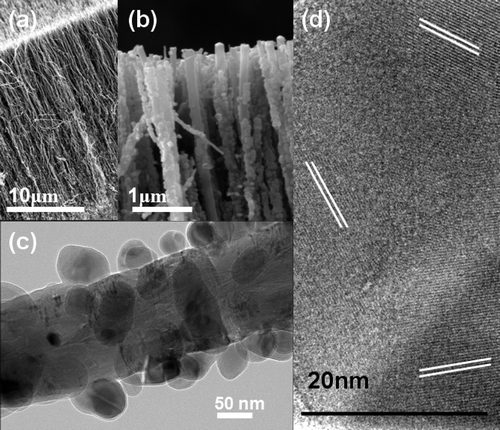| A facile approach to synthesize hybrid Si-CNT nanocomposites suitable for Li+ battery anodes has been reported. While cycling stability remains an issue, the materials still show significant improvements over present anode materials systems in terms of reversible capacity and rate limitations. |
Reviewed by Jeff Morse, Ph.D., National Nanomanufacturing Network
- Wang W and Kumta PN. 2010. Nanostructured Hybrid Silicon/Carbon Nanotube Heterostructures: Reversible High-Capacity Lithium-Ion Anodes. ACS Nano 4(4):2233–2241. doi: 10.1021/nn901632g.
In the search for high performance lithium ion (Li+) battery systems that will provide increased energy density along with improved cycling stability, silicon has emerged as a strong candidate to replace existing graphite anode systems due to its' inherently high capacity (theoretical specific capacity ~4200 mAh/g). To date, the utilization of silicon anodes in Li+ battery systems has been limited by rapid capacity degradation after only a few charge-discharge cycles resulting from substantial volume expansion due to phase transitions occurring during the Lithium alloying/dealloying processes. Such volume expansions lead to a rapid decrease in reversible capacity as the silicon essentially disintegrates. Although approaches employing porous silicon, silicon nanoparticles, and silicon coated carbon nanofibers have been investigated, they have shown limited improvements in cycling stability and capacity. Therefore methods to synthesize silicon anode structures that will retain the intrinsic capacity while demonstrating long term cycling stability and reversible capacity performance are necessary.
Recently Wang and Kumta reported on an investigation of synthesis routes to create a hybrid silicon-carbon nanotube (Si-CNT) nanostructure in order to address some of the challenges for applications to Li+ battery anodes. In this nanostructured materials approach, high-density, vertically aligned multi-walled carbon nanotubes (MWNTs) provide a high-surface area, mechanically robust electrode support structure with excellent electronic conductivity. The authors then investigated an approach to uniformly decorate the as-grown MWNTs with silicon nanoparticles of controlled size and distribution. In this manner the MWNT provides a high strength backbone to absorb residual stress created by the volume expansion of the silicon nanoparticles during lithium uptake. Furthermore, the bonding of the silicon nanoparticles to the MWNT via an amorphous carbon interface created during the silicon deposition process reaction facilitates rapid electron/ion charging via low resistance conduction paths as well as improved stability of the silicon nanostructures during the dealloying processes. The authors utilized a two-step chemical vapor deposition (CVD) process to prepare the hybrid nanostructures. Vertically aligned MWNTs were first grown using xylene as the hydrocarbon source and iron decomposed from ferrocene as the catalyst for MWNT growth. Silicon is then deposited on the as-grown vertically aligned MWNTs using silane gas as the reactant. The Si/C ratio is controlled by the total time of deposition, further enabling the electrochemical performance to be optimized.

Electrochemical characterization consisted of discharge/charge cycling at a C/10 rate, with initial discharge and charge capacities of 2552 and 2049 mAh/g respectively, representing a 19.7% irreversible capacity loss. The hybrid nanocomposite anode exhibits a fade rate of ~0.15% over the first 25 cycles, which then increase over cycles 25-100 before leveling out, at which point the capacity stabilizes at ~1000 mAh/g, which still represents a four-fold improvement over present graphite based anode materials. Thus a facile approach to synthesize hybrid Si-CNT nanocomposites suitable for Li+ battery anodes has been reported. While cycling stability remains an issue, the materials still show significant improvements over present anode materials systems in terms of reversible capacity and rate limitations. Further investigations into the underlying reasons for the capacity loss have the potential to realize high capacity, stable Li+ battery anode materials for next generation energy storage requirements.
Image reproduced with permission from Wang W and Kumta PN. 2010. Nanostructured Hybrid Silicon/Carbon Nanotube Heterostructures: Reversible High-Capacity Lithium-Ion Anodes. ACS Nano 4(4):2233–2241. doi: 10.1021/nn901632g. Copyright 2010 American Chemical Society.
This work is licensed under a Creative Commons Attribution-NonCommercial 3.0 Unported.
